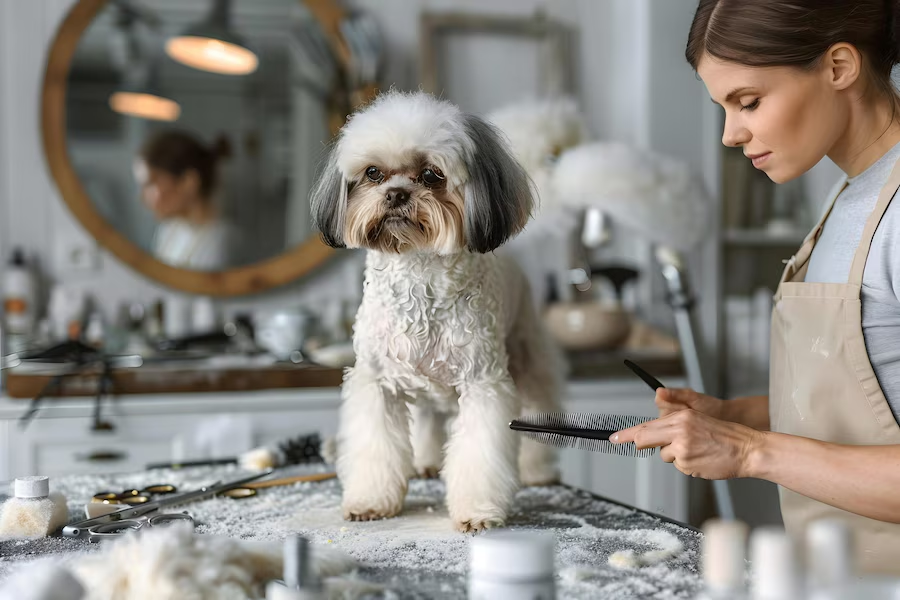Definition and Overview
Shedding is the process by which dogs lose old or damaged hair to make way for new growth. It is a natural and essential part of maintaining a healthy coat. Shedding varies from breed to breed and is influenced by factors such as genetics, diet, and overall health.
How Shedding Works in Dogs
Dogs have hair follicles that cycle through different stages: growth, rest, and shedding. Shedding occurs as old hair falls out to be replaced by new hair. This process is influenced by seasonal changes, health conditions, and grooming habits.
Understanding Pug Shedding
Why Do Pugs Shed?
Pugs shed due to their hair growth cycle, just like other dogs. They have a double coat, consisting of a soft undercoat and a coarse topcoat, which means they naturally shed hair regularly. Shedding helps them regulate body temperature and keep their coat healthy.
Pug Coat Characteristics
Pugs have a short, smooth coat that lies close to their body. This type of coat generally means less hair shedding compared to long-haired breeds, but pugs can still shed quite a bit, especially during seasonal changes.
Pug Shedding Patterns
Seasonal Shedding
Pugs typically shed more during seasonal changes, especially in spring and fall. This is when they shed their old coat to prepare for a new one that better suits the changing temperatures.
Health-Related Shedding
Excessive shedding can sometimes be a sign of health issues. If your pug is shedding more than usual or has bald patches, it could be due to factors like allergies, skin infections, or hormonal imbalances.
Managing Pug Shedding
Grooming Techniques
Regular grooming helps manage shedding and keeps your pug’s coat in good condition. Brushing your pug’s coat a few times a week can help remove loose hairs and reduce the amount of hair that ends up on your furniture and floors.
Best Tools for Grooming
Using the right grooming tools is crucial for managing shedding. A slicker brush or a rubber curry brush can effectively remove loose hairs from your pug’s coat. For deeper cleaning, consider a de-shedding tool that can reach the undercoat.
Diet and Its Impact on Shedding
Nutritional Needs of Pugs
A well-balanced diet is essential for maintaining a healthy coat. Pugs require a diet rich in proteins, healthy fats, and essential vitamins. These nutrients support skin health and reduce excessive shed-ding.
Foods that Promote Healthy Coats
Incorporate foods high in omega-3 and omega-6 fatty acids, such as fish oil or flaxseed, into your pug’s diet. These nutrients help keep their coat shiny and reduce shed-ding. Additionally, ensure they get plenty of vitamins A and E, which support skin health.
Health Issues and Excessive Shedding
Common Health Conditions
Certain health conditions can lead to increased shed-ding in pugs. These include:
- Allergies: Food or environmental allergies can cause itching and shed-ding.
- Parasites: Fleas or mites can irritate the skin and lead to hair loss.
- Hormonal Imbalances: Conditions like hypothyroidism can affect coat health.
When to See the Vet
If you notice significant changes in your pug’s shed-ding patterns or if they have patches of baldness, consult your veterinarian. They can diagnose underlying health issues and recommend appropriate treatments.
Creating a Pet-Friendly Home
Cleaning Tips for Shedding
To manage the hair that your pug sheds, use a vacuum cleaner with a pet hair attachment and wash pet bedding regularly. Lint rollers can also be handy for quick clean-ups of hair on furniture and clothing.
Furniture and Fabric Considerations
Opt for washable or easy-to-clean fabrics for your furniture. Consider using covers or throws that can be removed and washed to minimize the impact of pet hair.
Myths and Facts About Pug Shedding
Debunking Common Myths
Myth: Pugs don’t shed much because they have short hair.
Fact: While pugs do have a short coat, they still shed regularly. Short hair can make it more noticeable when they shed.
Myth: Bathing a pug more frequently will reduce shed-ding.
Fact: Overbathing can actually dry out a pug’s skin, leading to more shed-ding. Stick to regular grooming and bathing as needed.
Understanding the Facts
Pug shedding is a normal process, and while it can be managed, it cannot be completely eliminated. Proper grooming, a healthy diet, and regular veterinary check-ups can help keep shed-ding under control.
Conclusion
Understanding pug shedding helps in managing it effectively and maintaining a clean and comfortable environment for both you and your pet. By adopting proper grooming techniques, providing a balanced diet, and addressing any health issues promptly, you can keep your pug’s shed-ding to a manageable level while ensuring they stay healthy and happy.
FAQs
- How often should I brush my pug?
- Brushing your pug 2-3 times a week helps manage shed-ding and keeps their coat in good condition.
- Do pugs shed more during certain seasons?
- Yes, pugs typically shed more during spring and fall as they transition between their winter and summer coats.
- What can I do if my pug sheds excessively?
- If your pug sheds excessively, check for underlying health issues, improve their diet, and consult with your vet if necessary.
- Are there specific foods that help with shedding?
- Foods rich in omega-3 and omega-6 fatty acids, such as fish oil and flaxseed, help promote a healthy coat and reduce shedding.
- How can I reduce the amount of pug hair in my home?
- Use a vacuum with a pet hair attachment, wash pet bedding regularly, and choose easy-to-clean furniture fabrics to manage pet hair in your home.










